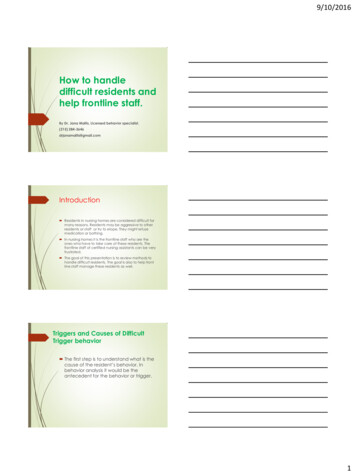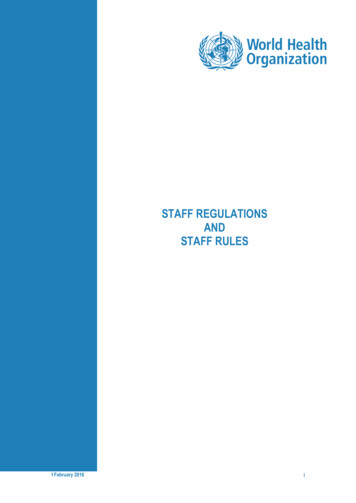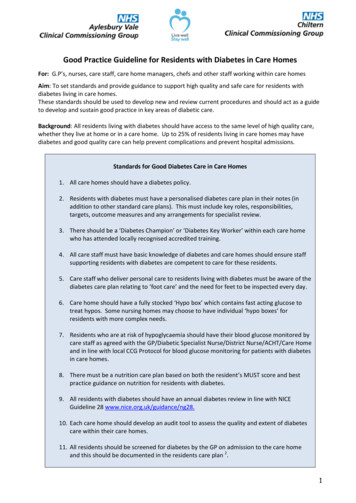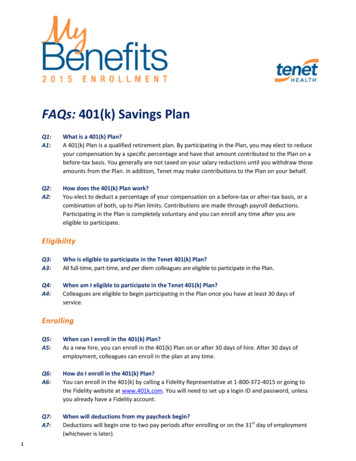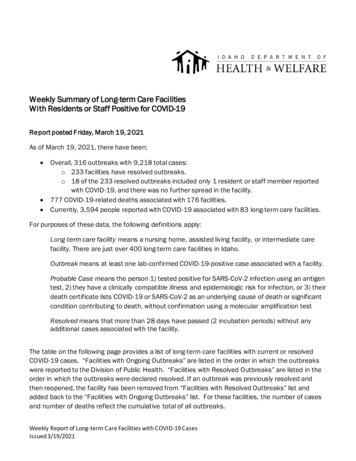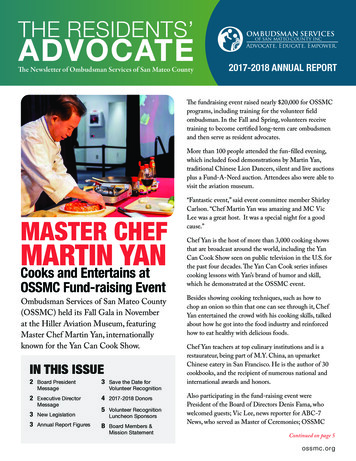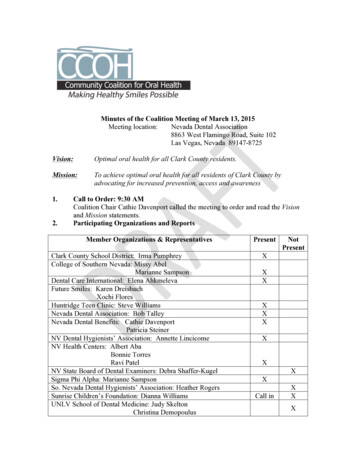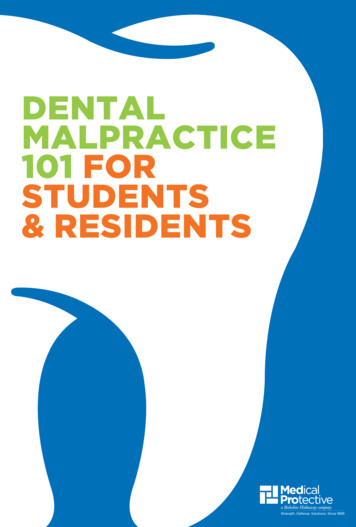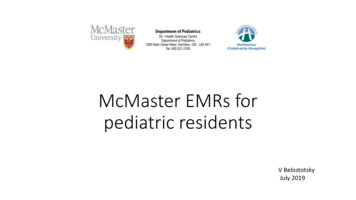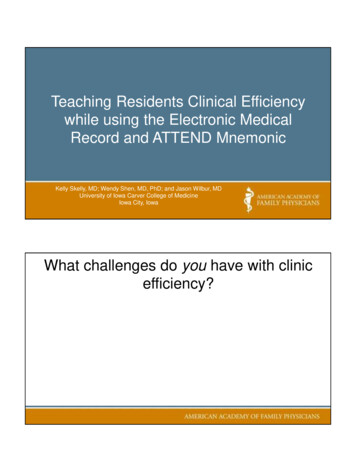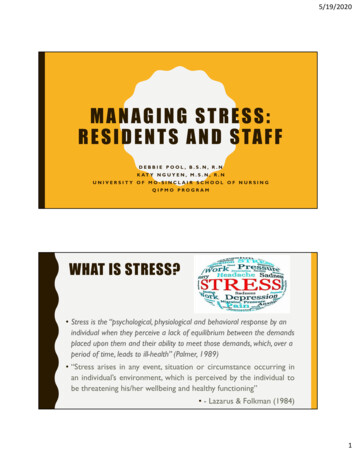
Transcription
5/19/2020MANAGING STRESS:R E S I D E N T S A N D S TA F FDEBBIE POOL, B.S.N, R.NK AT Y N G U Y E N , M . S . N , R . NUNIVERSITY OF MO-SINCLAIR SCHOOL OF NURSINGQIPMO PROGRAMWHAT IS STRESS? Stress is the “psychological, physiological and behavioral response by anindividual when they perceive a lack of equilibrium between the demandsplaced upon them and their ability to meet those demands, which, over aperiod of time, leads to ill-health” (Palmer, 1989) “Stress arises in any event, situation or circumstance occurring inan individual’s environment, which is perceived by the individual tobe threatening his/her wellbeing and healthy functioning” - Lazarus & Folkman (1984)1
5/19/2020RESIDENT STRESS Frustration and boredom related to the isolation of quarantine Unable to have visitors Lack of communication and psychosocial supports from family Tense environments (many people wearing PPEs, no home likeenvironment ) Fears Lack of information or too much misinformation Change in routines Unable to have peer support No social interactions Being watched and checked more often (temp, S&S)STAFF: STRESS WHAT? A threat to the worker’s personal/family health and life A loss of colleagues or threat to professional mastery and identity An inner conflict between ones values and aspirations and what they are able toaccomplish in their work Fatigue, simply feeling worn out by the relentless work and need, without time for restand recovery Inadequate supplies and access to regular medical care Fears about becoming infected and/or infecting others Work-Life Balance: extra shift to cover call-in, no show2
5/19/2020SYMPTOMS OF STRESS Difficulty sleeping Stomach pain Teeth grinding Headaches Anger, Outburst Having stomachaches or diarrhea Having headaches and other pains Losing your appetite or eating toomuch Sweating or having chills Restlessness; Fatigue Getting tremors or muscletwitches Lack of motivation or focus Being easily startled Social isolation Sweaty hands or feet Nausea Heartburn Weight gain or weight loss Excessive sleepingSYMPTOMS OF STRESS Difficulty concentrating; thinkingclearly Being anxious or fearful Obsessive or compulsive behaviors Feeling guilty Feeling overwhelmed Feeling angry Irritability or anger Sadness or depression Display unwanted/undesired actions Irritability; Panic attacks Having trouble remembering things Feeling depressed Feeling heroic, euphoric, orinvulnerable Not caring about anything Feeling overwhelmed by sadness Feeling confused Having difficulty making decisions3
5/19/2020WHAT IS STRESS MANAGEMENT? “set of techniques and programs intended to help peopledeal more effectively with stress in their lives byanalyzing the specific stressors and taking positiveactions to minimize their effects” (Gale Encyclopaedia ofMedicine, 2008)MANAGING STRESS: STAFF Schedule and take brief breaks to care for your basic needs. Schedule and take brief relaxation breaks at work. A few minutesof a break during a shift can be calming. Even a 5-minute walk canimprove energy and focus. Take time each day to do something that brings you joy, even ifjust for a brief moment. Maintain a healthy diet; bring your own meals to work. Keep your schedule of daily activities as regular as you can. Make time to unwind. Try to do some other activities you enjoy. Connect with others. Talk with people you trust about yourconcerns and how you are feeling.4
5/19/2020MANAGING STRESS: STAFF Avoid or limit use of alcohol and caffeine. Watch for excessive fatigue, irritability, poor focus, oranxiety. Pace yourself. Take a moment for a slow breath before entering awork area, If a spiritual practice is important to youor has been in the past, work it into your regularroutine. Get some sunlight. Try chair yoga or stretching at work. Get regular exercise. Try walking or biking to work ifyou can.MANAGING STRESS FOR STAFF Personal safety and Family safety Support to work: Transportation and parking; Logging;Meals, Snacks Communication Psychological safety; Peer support Mental health liaisons; Mental health crisis team Self-care; Retraining Mentorship;Teamwork Daily huddles: time for the staff to provide input and help refine thework as they do the work5
5/19/2020MANAGING STRESS FOR STAFF Develop and provide materials that includeevidence-informed coping tips and self-care facts Direct people to resources Promotes social connectedness, calming---ratherthan fear---and feelings of safety and hope Provide guidance about building resilience, including tips for increasingsocial support, maintaining optimism, setting goals, achieving emotionaland social balance, and employing multiple types of problem-solving andcopingWHAT DO YOU DO FOR YOUR STAFF Check in with staff frequently: at least weekly Regard how they are doing and feeling, and how their families are doing Show your support and care for staff Make sure staff are taking care of themselves (e.g. encourage staff to take afive-min mental health break, provide lunch or food to make sure they areeating well) Allowing them time to call family during shifts if needed to check on them Understand and Identify Burnout Recognize Secondary traumatic stress – stress reactions and symptomsresulting from exposure to another individual’s traumatic experiences, ratherthan from exposure directly to a traumatic event6
5/19/2020WHAT TO DO FOR YOUR STAFF Emergency Assistance Programs Set up a Quiet Room for Staff Ensure Staff Can Access Food and Other Essentials Connect staff with resources for childcare. Engage appreciation from residents/other staff/families, andappreciation from leadership Establish Buddy system Provide assistance, help linesMANAGING STRESS Relax your body often by doing things that work for you—take deep breaths, stretch, meditate, wash your face andhands, or engage in pleasurable hobbies. Pace yourself between stressful activities, and do a funthing after a hard task. Use time off to relax—eat a good meal, read, listen tomusic, take a bath, or talk to family. Talk about your feelings to loved ones and friends often.7
5/19/2020CONTACTS-HELPS Need help? Know someone who does? If you, or someone you care about, are feeling overwhelmed with emotions like sadness, depression,or anxiety, or feel like you want to harm yourself or others Call 911 Visit the Disaster Distress Helplineexternal icon, call 1-800-985-5990, or text TalkWithUs to 66746 Visit the National Domestic Violence Hotlineexternal icon or call 1-800-799-7233 and TTY 1-800787-3224 SAMHSA Hotlines SAMHSA’s Disaster Distress Helpline Toll-Free: 1-800-985-5990 (English andespañol) SAMHSA’s National Helpline Toll-Free: 1-800-662-HELPHOW ABOUT HUMOR? Humor is coping mechanism: Manage Stress, Maintain Emotional Well-Being Humor helps us take back control and connect Relax the fears for a moments Help attachments with others and binds people together via laughs Help lessening tensions Help to resolve conflicts Help to relieve setbacks Help Alleviate Anxiety and Depression Avoid offense humor or mocking pictures, videos and words People take humor differently. Ask before “is it ok to joke”8
5/19/2020MANAGING STRESS FOR RESIDENTS Meet basic needs: Eating, hydrating, sleeping Rest and relaxing activities that meet the social distancing guidelines. Help resident to stay connected: Helping residents to give and receive supportfrom family, friends, churches can reduce feelings of isolation. *Inform and update the information to residents and family! Be transparent! Monitor for signs of increased stress. Talk to a family member, friend, peer or supervisor if needed. Recognize residents for their support and cooperation with guidelines andfacility’s policies during this crisis Promote senses of safety9
5/19/2020MANAGING STRESS FOR RESIDENTS Education: basic hygiene such as hand-washing and cough etiquette Let residents know what you, your office, or your organization is doing toreduce the risk of exposure. Limit media exposure. Take a break from media coverage of COVID-19 Acknowledge signs of distress, and teach residents to recognize the signs ofdistress, including worry, fear, insomnia, difficulty concentrating, interpersonalproblems Get some sunlight Spiritual practice if applicable Support families if resident is infected or passes away Reduce boredom and isolationMANAGING STRESS FOR RESIDENTS Help connect people with family and loved ones to help lowerdistress and feelings of social isolation. Let older adults and people with disabilities know it iscommon for people to feel distressed during a crisis. Remindthem that asking for and accepting help is a sign of strength. Have a procedure and referrals ready for anyone who showssevere distress or expresses a desire to hurt him- or herself orsomeone else.10
5/19/2020MANAGING BOREDOM Technology: computers, tablets, e-readers, explore virtual activities, games Reading: Magazines/Newspapers/Books, etc. Read a book via intercom if applicable Radios, music; TV in room Arts and Crafts: Crossword puzzles, Sudoku, Adult coloring books Knitting , Sewing, Cross Stitch, Needlepoint, Jewelry-making, Macramé , Quilting,Painting – watercolors, finger paints, paint-by-numbers, etc. Puzzles – for adults living with dementia, consider large pieces and puzzles withfewer pieces , Scrapbooking – reminiscent pages of their life or favorite things Explore more arts and crafts ideas online Exercise/Movement/DancingMANAGING BOREDOM Music Therapy Board games/card games : Solitaire or Free cell Meditation Movies in social distancing Bingo Over the Intercom Ice Cream Non-Social or in social distancing Trivia Question for the Day Bird Watching if available Journaling – have residents write something new each day, writedown what they are thankful for each day11
5/19/2020HELPING STRESS FOR RESIDENT’SFAMILY Keep the lines of communication open utilizing phone calls, face time, zoom,skype or other means Allow families the opportunity to share concerns, frustrations and/orcompliments Assign staff as primary contact to families for inbound calls, conduct regularoutbound calls to keep families updated Host “virtual office hours” with conference calls or webinars where familiescan call in or log on with facility staff to share activities or happenings withinthe facility and families may ask questions or make suggestionsCOMMON REACTIONS TO COVID-19 Concern about protecting oneself from the virus because they are at higher risk of seriousillness. Concern that regular medical care or community services may be disrupted due tofacility closures or reductions in services and public transport closure. Feeling socially isolated, especially if they live alone or are in a community setting that is notallowing visitors because of the outbreak. Guilt if loved ones help them with activities of daily living. Increased levels of distress if they:– Have mental health concerns before the outbreak, such as depression.– Live in lower-income households or have language barriers– Experience stigma because of age, race or ethnicity, disability, or perceived likelihood of spreadingCOVID-19.(CDC )12
5/19/2020TOOLS AND TIPSCMS QSO-20-30-NH MAY 18, 202013
5/19/2020CMS TOOLKIT ON STATE ACTIONS TO MITIGATECOVID-19 PREVALENCE IN NURSING HOMESMAY, 2020 Reporting/Guidance/ Mandated ReportingContinued Missouri (MO) The Quality ImprovementProgram for Missouri (QIPMO) QIPMO is acooperative service between the University ofMissouri Sinclair School of Nursing and theMissouri Department of Health and SeniorServices. It is composed of gerontological nurseswho provide education on state actions toimprove care delivery and outcomes for nursinghome residents Resources Continued Missouri (MO) TheQuality Improvement Program for Missouri(QIPMO) In addition to an online COVID-19resource compendium, QIPMO recentlydeveloped a COVID-19 SBAR (Situation,Background, Appearance/Assessment, Review/Recommendation) tool for nursing homes TheCOVID-19 SBAR is used by facilities to documentand communicate changes in resident status dueto COVID-19 that would require action to betaken such as transfer to acute content/uploads/2020/03/SBAR-for-COVID-19.pdfDHSS PPE UPDATE: MAY 15, 2020 PPE Updates In an effort to expand the PPE reserves and simplify the PPE process, the state has created a newCOVID-19 webpage dedicated to be a one-stop shop for all information related to PPE. The PPEwebpage will provide Missouri’s latest information and resources in three categories including howto access PPE, guidance for use and optimization for maintaining your PPE supply for the duration ofthe COVID-19 epidemic. You can use this website to access the PPE marketplace, too. Also, NEW to this website and to the state is the State PPE Reserves option.14
5/19/2020DHSS PPE UPDATE Missouri has limited PPE reserves to assist in filling these critical needs and will prioritize healthcareproviders providing direct care to confirmed or suspected COVID patients. Note requests shouldonly be submitted after all normal supply chains, including the Missouri COVID Supply Solution (akaMissouri PPE Marketplace), have been exhausted and you have a supply of fourteen days or less onhand as the quantities and types of PPE available through the state are limited. Use thislink 09028d2caf9fd45fd?portalUrl http://mophep.maps.arcgis.com to access the PPE Request Form. You will receive an automaticallygenerated email notifying you of receipt of your request. Requests will be evaluated in the order inwhich they are received. If your request is approved, either in full or partially, you will receive anelectronic notification upon shipment. If denied, you will receive an electronic verification of thedecision.15
5/19/20205/13/20 CMS CALL WITH NURSING HOMESFEDERAL INFECTION CONTROL SURVEYFINDINGSThree major areas for improvement: Hand hygiene: lack of hand hygiene when moving from Covid to non-Covidresident/room, touching of resident items, observation of no hand hygiene bynursing/housekeeping PPE: inappropriate use, Don/Doff incorrectly, mask on incorrectly with nosenot covered, Signage/Cohorting: Lack of appropriate cohorting of residents and staff lackedawareness of Covid positive residents16
5/19/2020FEDERAL IC SURVEY ADDITIONALAREAS OF CONCERN Inconsistent staff screening Physician notification of resident change in condition Back up for Infection Preventionist N95s not fit tested Inadequate cleaning of equipment: BP cuffs, glucometers, pulse oximeters Need for more robust monitoring of residents, increase frequency ofassessments and documentation Ongoing staff education disease spread, PPE use/misuse17
5/19/2020MDS 3.0 TECHNICAL INFORMATION May 15, 2020 In response to State Medicaid Agency and stakeholder requests, CMS has updated the MDS 3.0 itemsets (version 1.17.2) and related technical data specifications. These changes will support thecalculation of PDPM payment codes on OBRA assessments when not combined withthe 5-day SNF PPS assessment, specifically the OBRA comprehensive (NC) and OBRAquarterly (NQ) assessment item sets, which was not possible with item set version1.17.1. This will allow State Medicaid Agencies to collect and compare RUG-III/IV payment codesto PDPM ones and thereby inform their future payment models. The changes to the technical data specifications that support these modifications are contained inthe Errata v3.00.4 which can be accessed in the file: MDS 3.0 data specs errata (v3.00.4) Final 04-302020 in the Downloads section below. Supporting materials including the 1.17.2 Item ChangeHistory report and the revised 1.17.2 Item Sets can be accessed in the file: MDS 3.0 Final Item Setsv1.17.2 for October 1 2020 zip also posted in the Downloads section below. Please confirm with your State Medicaid Agency if your State will be requiring the calculation of thePDPM payment codes on the OBRA assessments when not combined with a 5-day SNF PPSassessment. ts/NHQIMDS30TechnicalInformation18
5/19/2020SHARING YOUR VICTORY! We ask that you share your victoryand/or your plan on how you helpyour staff and residents cope withthis crisis? Tap to unmute yourself to speakwith us19
5/19/2020RESOURCESReference: American Psychiatric Association American Medical Association National Center for PTSD https://www.ptsd.va.gov WHO AHCA/MHCA CDC DHSS list serve May 15, 2020 ts/NHQIMDS30TechnicalInformation dfEVALUATION https://bit.ly/QIPMOVirtualSG20
Program for Missouri (QIPMO) QIPMO is a cooperative service between the University of Missouri Sinclair School of Nursing and the Missouri Department of Health and Senior Services. It is composed of gerontological nurses who provide education on state actions to improve care delivery and outcomes for nursing home residents
